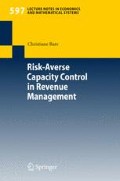Abstract
As mentioned before, the assumption of an additive time-separable utility function  for all time periods n = 0, . . ., N, is the one most frequently used in combination with Markov decision processes. Yet, as indicated in Chap. 3, it imposes a special structure of temporal and risk preferences.
for all time periods n = 0, . . ., N, is the one most frequently used in combination with Markov decision processes. Yet, as indicated in Chap. 3, it imposes a special structure of temporal and risk preferences.
Access this chapter
Tax calculation will be finalised at checkout
Purchases are for personal use only
Preview
Unable to display preview. Download preview PDF.
Rights and permissions
Copyright information
© 2007 Springer-Verlag Berlin Heidelberg
About this chapter
Cite this chapter
(2007). Capacity Control Maximizing Additive Time-Separable Utility. In: Risk-Averse Capacity Control in Revenue Management. Lecture Notes in Economics and Mathematical Systems, vol 597. Springer, Berlin, Heidelberg. https://doi.org/10.1007/978-3-540-73014-9_6
Download citation
DOI: https://doi.org/10.1007/978-3-540-73014-9_6
Publisher Name: Springer, Berlin, Heidelberg
Print ISBN: 978-3-540-73013-2
Online ISBN: 978-3-540-73014-9
eBook Packages: Business and EconomicsBusiness and Management (R0)

